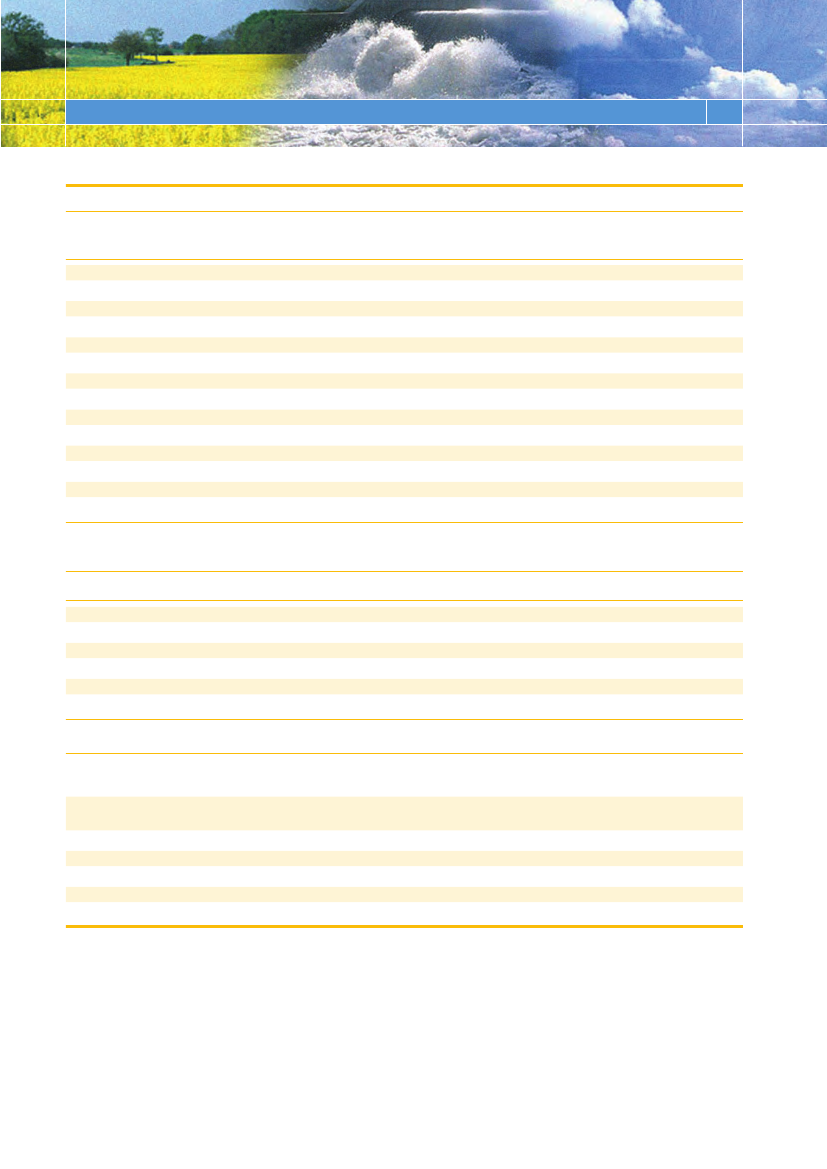Det Energipolitiske Udvalg 2009-10
EPU Alm.del Bilag 373
Offentligt
RENEWABLES 2010 GLOBAL STATUS REPORT
9
EXECUTIVE SUMMARYChanges in renewable energy markets, investments, indus-tries, and policies have been so rapid in recent years thatperceptions of the status of renewable energy can lag yearsbehind the reality. This report captures that reality and pro-vides a unique overview of renewable energy worldwide asof early 2010. The report covers both current status and keytrends. By design, the report does not provide analysis, dis-cuss current issues, or forecast the future.Many of the trends reflect the increasing significance ofrenewable energy relative to conventional energy sources(including coal, gas, oil, and nuclear). By 2010, renewableenergy had reached a clear tipping point in the context ofglobal energy supply. Renewables comprised fully one-quarter of global power capacity from all sources and deliv-ered 18 percent of global electricity supply in 2009. In anumber of countries, renewables represent a rapidly grow-ing share of total energy supply—including heat and trans-port. The share of households worldwide employing solarhot water heating continues to increase and is now estima-ted at 70 million households. And investment in newrenewable power capacity in both 2008 and 2009 repre-sented over half of total global investment in new powergeneration.Trends reflect strong growth and investment across all mar-ket sectors—power generation, heating and cooling, andtransport fuels. Grid-connected solar PV has grown by anaverage of 60 percentevery yearfor the pastdecade,increasing 100-fold since 2000. During the past five yearsfrom 2005 to 2009, consistent high growth year-after-yearmarked virtually every other renewable technology. Duringthose five years, wind power capacity grew an average of27 percent annually, solar hot water by 19 percent annually,and ethanol production by 20 percent annually. Biomassand geothermal for power and heat also grew strongly.Much more active policy development during the past sev-eral years culminated in a significant policy milestone in early2010—more than 100 countries had enacted some type ofpolicy target and/or promotion policy related to renewableenergy, up from 55 countries in early 2005. Many new tar-gets enacted in the past three years call for shares of energyor electricity from renewables in the 15–25 percent range by2020. Most countries have adopted more than one promo-tion policy, and there is a huge diversity of policies in placeat national, state/provincial, and local levels.Many recent trends also reflect the increasing significance ofdeveloping countries in advancing renewable energy. Collec-tively, developing countries have more than half of globalrenewable power capacity. China now leads in several indi-cators of market growth. India is fifth worldwide in totalexisting wind power capacity and is rapidly expanding manyforms of rural renewables such as biogas and solar PV. Brazilproduces virtually all of the world’s sugar-derived ethanoland has been adding new biomass and wind power plants.Many renewables markets are growing at rapid rates incountries such as Argentina, Costa Rica, Egypt, Indonesia,Kenya, Tanzania, Thailand, Tunisia, and Uruguay, to name afew. Developing countries now make up over half of allcountries with policy targets (45 out of 85 countries) andalso make up half of all countries with some type of renew-able energy promotion policy (42 out of 83 countries).The geography of renewable energy is changing in waysthat suggest a new era of geographic diversity. For example,wind power existed in just a handful of countries in the1990s but now exists in over 82 countries. Manufacturingleadership is shifting from Europe to Asia as countries likeChina, India, and South Korea continue to increase theircommitments to renewable energy. In 2009, China pro-duced 40 percent of the world’s solar PV supply, 30 percentof the world’s wind turbines (up from 10 percent in 2007),and 77 percent of the world’s solar hot water collectors.Latin America is seeing many new biofuels producers incountries like Argentina, Brazil, Colombia, Ecuador, and Peru,as well as expansion in many other renewable technologies.At least 20 countries in the Middle East, North Africa, andsub-Saharan Africa have active renewable energy markets.Outside of Europe and the United States, other developedcountries like Australia, Canada, and Japan are seeing recentgains and broader technology diversification. The increasinggeographic diversity is boosting confidence that renewablesare less vulnerable to policy or market dislocations in anyspecific country.One of the forces propelling renewable energy developmentis the potential to create new industries and generate mil-lions of new jobs. Jobs from renewables now number inthe hundreds of thousands in several countries. Globally,there are an estimated 3 million direct jobs in renewableenergy industries, about half of them in the biofuels industry,with additional indirect jobs well beyond this figure.Greatly increased investment from both public-sector anddevelopment banks is also driving renewables development,particularly from banks based in Europe, Asia, and SouthAmerica. The European Investment Bank and the BrazilianDevelopment Bank (BNDES) are notable cases. A number ofdevelopment banks have increased development assistanceflows. Such flows jumped to over $5 billion in 2009, com-pared with some $2 billion in 2008. The largest providers arethe World Bank Group, Germany’s KfW, the Inter-AmericanDevelopment Bank, and the Asian Development Bank.Dozens of other development agencies provide growingamounts of loans, grants, and technical assistance for renew-ables.
10
RENEWABLES 2010 GLOBAL STATUS REPORT
Other ongoing market and industry trends include:Wind power.Trends include new growth in off shoredevelopment, the growing popularity of distributed, small-scale grid-connected turbines, and new wind projects in amuch wider variety of geographical locations around theworld and within countries. Firms continue to increase aver-age turbine sizes and improve technologies, such as withgearless designs.Biomass power.Biomass power plants exist in over 50countries around the world and supply a growing share ofelectricity. Several European countries are expanding theirtotal share of power from biomass, including Austria (7 per-cent), Finland (20 percent), and Germany (5 percent). Biogasfor power generation is also a growing trend in severalcountries.Grid-connected solar PV.The industry has been respond-ing to price declines and rapidly changing market conditionsby consolidating, scaling up, and moving into project devel-opment. Thin-film PV has experienced a rapidly growingmarket share in recent years, reaching 25 percent. A gro-wing of number of solar PV plants are so-called “utility-scale” plants 200-kW and larger, which now account forone-quarter of total grid-connected solar PV capacity.Geothermal power.Geothermal power plants now exist in19 countries, and new plants continue to be commissionedannually—for example in Indonesia, Italy, Turkey, and theUnited States in 2009.Concentrating solar thermal power (CSP).CSP emergedas a significant new power source during 2006–2010, afterinitial stalled development some two decades earlier. Byearly 2010, 0.7 GW of CSP was in operation, all in the U.S.Southwest and Spain, with construction or planning underway for much more capacity in many more countries.Solar hot water/heating.China continues to dominate theworld market for solar hot water collectors, with some 70percent of the existing global capacity. Europe is a distantsecond with 12 percent. Virtually all installations in China arefor hot water only. But there is a trend in Europe towardlarger ‘combi’ systems that provide both water and spaceheating; such systems now account for half of the annualmarket.Biomass and geothermal heating.Biomass heating mar-kets are expanding steadily, particularly in Europe. Trendsinclude growing use of solid biomass pellets, use of bio-mass in building-scale or community-scale combined-heat-and-power plants (CHP), and use of biomass for centralizeddistrict heating systems. Use of geothermal direct-use heatplants and ground-source heat pumps is also growing.
Globally, there exists some 500 gigawatts-thermal (GWth)of heating capacity from biomass (270 GWth), solar (170GWth), and geothermal (60 GWth).Biofuels.Corn ethanol, sugar ethanol, and biodiesel are theprimary biofuels markets, although others like biogas fortransport and other forms of ethanol are also significant.Corn accounts for more than half of global ethanol produc-tion, and sugar cane for more than one-third. The UnitedStates and Brazil accounted for almost 90 percent of globalethanol production. The second-generation biofuels industryhas seen many research and pilot-production plants com-missioned, most with some form of partial public funding.
Highlights of 2009The year 2009 was unprecedented in the history of renew-able energy, despite the headwinds posed by the globalfinancial crisis, lower oil prices, and slow progress with cli-mate policy. Indeed, as other economic sectors declinedaround the world, existing renewable capacity continued togrow at rates close to those in previous years, includinggrid-connected solar PV (53 percent), wind power (32 per-cent), solar hot water/heating (21 percent), geothermalpower (4 percent), and hydropower (3 percent). Annualproduction of ethanol and biodiesel increased 10 percentand 9 percent, respectively, despite layoffs and ethanol plantclosures in the United States and Brazil.Highlights of 2009 include:�For the second year in a row, in both the United Statesand Europe, more renewable power capacity wasadded than conventional power capacity (coal, gas,nuclear). Renewables accounted for 60 percent of newlyinstalled power capacity in Europe in 2009, and nearly20 percent of annual power production.�China added 37 GW of renewable power capacity, morethan any other country in the world, to reach 226 GWof total renewables capacity. Globally, nearly 80 GW ofrenewable capacity was added, including 31 GW ofhydro and 48 GW of non-hydro capacity.�Wind power additions reached a record high of 38 GW.China was the top market, with 13.8 GW added, repre-senting more than one-third of the world market—upfrom just a 2 percent market share in 2004. The UnitedStates was second, with 10 GW added. The share ofwind power generation in several countries reachedrecord highs, including 6.5 percent in Germany and 14percent in Spain.�Solar PV additions reached a record high of 7 GW.Germany was the top market, with 3.8 GW added, or
RENEWABLES 2010 GLOBAL STATUS REPORT
11
more than half the global market. Other large marketswere Italy, Japan, the United States, Czech Republic, andBelgium. Spain, the world leader in 2008, saw installa-tions plunge to a low level in 2009 after a policy capwas exceeded.�Many countries saw record biomass use. Notable wasSweden, where biomass accounted for a larger share ofenergy supply than oil for the first time.�Biofuels production contributed the energy equivalent of5 percent of world gasoline output.�Almost all renewable energy industries experiencedmanufacturing growth in 2009, despite the continuingglobal economic crisis, although many capital expansionplans were scaled back or postponed. Impaired accessto equity markets, difficulty in obtaining finance, andindustry consolidations negatively affected almost allcompanies.�Nearly 11 GW of solar PV was produced, a 50-percentincrease over 2008. First Solar (USA) became the firstfirm ever to produce over 1 GW in a single year. Majorcrystalline module price declines took place, by 50–60percent by some estimates, from highs of $3.50 perwatt in 2008 to lows approaching $2 per watt.�Wind power received more than 60 percent of utility-scale renewables investment in 2009 (excluding smallprojects), due mostly to rapid expansion in China.�Investment totals in utility-scale solar PV declined relativeto 2008, partly an artifact of large drops in the costs ofsolar PV. However, this decline was offset by recordinvestment in small-scale (rooftop) solar PV projects.�Investment in new biofuels plants declined from 2008rates, as corn ethanol production capacity was not fullyutilized in the United States and several firms wentbankrupt. The Brazilian sugar ethanol industry likewisefaced economic troubles, with no growth despiteongoing expansion plans. Europe faced similar softeningin biodiesel, with low production capacity utilization.�"Green stimulus" efforts since late-2008 by many of theworld's major economies totaled close to $200 billion,although most stimulus was slow to start and less than10 percent of green stimulus funds was spent during2009.For more 2009 data and country rankings, see the SelectedIndicators and Top Five Countries tables on page 13.
A Dynamic Policy LandscapePolicies to promote renewable energy existed in a fewcountries in the 1980s and early 1990s, but policiesemerged in many more countries, states, provinces, andcities during the past 15 years and especially during theperiod 2005–2010.By 2009, over 85 countries had some type of policy target,up from 45 countries in 2005. Many national targets are forshares of electricity production, typically 5–30 percent, butrange as high as 90 percent. Other targets are for shares oftotal primary or final energy supply (typically 10–20 per-cent), specific installed capacities of various technologies, ortotal amounts of energy production from renewables. Mostrecent targets aim for 2020 and beyond. Europe’s target (20percent of final energy by 2020) is prominent among OECDcountries. Among developing countries, examples includeBrazil (75 percent of electricity by 2030), China (15 percentof final energy by 2020), India (20 GW solar by 2022), andKenya (4 GW of geothermal by 2030). Many targets alsoexist at the state, provincial, and local levels.At least 83 countries have some type of policy to promoterenewable power generation. The most common policy isthe feed-in tariff, which has been enacted in many newcountries and regions in recent years. By early 2010, at least50 countries and 25 states/provinces had feed-in tariffs,more than half of these adopted only since 2005. Strongmomentum for feed-in tariffs continues around the worldas countries continue to establish or revise policies. Statesand provinces have been adopting feed-in tariffs in increas-ing numbers as well.Renewable portfolio standard (RPS) policies, also calledrenewable obligations or quotas, have been enacted by 10national governments and 46 state/provincial governmentsaround the world. Most RPS policies require renewablepower shares in the range of 5–20 percent, with manytargets extending to 2020 and beyond.Many other types of policies have been adopted, mostoften in combination. Some type of direct capital investmentsubsidy, grant, or rebate is offered in at least 45 countries.Investment tax credits, import duty reductions, and/or othertax incentives are also common policies at national andstate/provincial levels. Capital subsidies and tax credits havebeen particularly instrumental in supporting solar PV mar-kets, with new solar PV rooftop programs announced inseveral countries in 2009. Energy production payments,sometimes called “premiums,” exist in a handful of coun-tries. Countries continue to adopt public competitive biddingfor fixed quantities of renewable power capacity. And netmetering laws for distributed generation now exist in atleast 10 countries and in 43 U.S. states.
12
RENEWABLES 2010 GLOBAL STATUS REPORT
Policies for solar and other renewable hot water and heat-ing were adopted with increasing frequency during 2006–2010. A growing number of countries, states, and citiesmandate solar hot water in new building construction,spanning all continents and economic development levels.In Europe, a new crop of policies supporting renewableheating has emerged in recent years, such as Germany’sRenewable Heating Law, which requires 20 percent mini-mum heating from renewables in new residential buildings.And at least 20 countries, and probably several more, pro-vide capital grants, rebates, VAT exemptions, or investmenttax credits for solar hot water/heating investments.Mandates for blending biofuels into vehicle fuels have beenenacted in at least 41 states/provinces and 24 countries atthe national level. Most mandates require blending 10–15percent ethanol with gasoline or blending 2–5 percentbiodiesel with diesel fuel. Fuel-tax exemptions and produc-tion subsidies are also common. In addition, biofuels targetsor plans exist in more than 10 countries and the EU. Thesetargets call for specific shares of transport energy frombiofuels (e.g., 10 percent by 2020 in the EU) or total annualbiofuels production (e.g., 130 billion liters/year by 2022 inthe United States).City and local governments around the world are alsoenacting renewable energy promotion policies. Hundredsof cities and local governments have established futuretargets for renewables; urban planning that incorporatesrenewables into city development; building codes that man-date or promote renewables; tax credits and exemptions;purchases of renewable power or fuels for public buildingsand transit; innovative electric utility policies; subsidies,grants, or loans; and many information and promotionactivities.
purification, and heating and cooling. Most renewable tech-nologies can be employed in homes, schools, hospitals,agriculture, and small industry.The number of rural households served by renewableenergy is difficult to estimate, but runs into the tens of mil-lions considering all forms of renewables. Micro-hydroconfigured into village-scale or county-scale mini-gridsserves many of these. More than 30 million households getlighting and cooking from biogas made in household-scaledigesters. An estimated 3 million households get powerfrom small solar PV systems. Biomass cookstoves are usedby 40 percent of the world’s population, and a new gen-eration of more-efficient “improved” biomass cook stoveshas emerged over the years. These stoves are being manu-factured in factories and workshops worldwide, and morethan 160 million households now use them.
Rural Renewable EnergyRenewable energy has an important role in providingmodern energy access to the billions of people in develop-ing countries that continue to depend on more traditionalsources of energy. Some 1.5 billion people worldwide stilllack access to electricity, and approximately 2.6 billion arereliant on wood, straw, charcoal, or dung for cooking theirdaily meals. A rural transition from traditional to moremodern forms of energy is under way in households andsmall industries in many countries.Renewable energy is playing a key role in this transition. Ineven the most remote areas, renewable energy technolo-gies such as solar PV household systems, micro-hydro mini-grids, biogas digesters, biofuels engines, solar- and wind-powered water pumps, and solar water heaters are pro-viding basic necessities of modern life, including lighting,cooking, communications, motive power, irrigation, water
RENEWABLES 2010 GLOBAL STATUS REPORT
13
SELECTED INDICATORS AND TOP FIVE COUNTRIES
SELECTED INDICATORSInvestment in new renewable capacity (annual)Renewables power capacity (including only small hydro)1Renewables power capacity (including all hydro)Hydropower capacity (existing, all sizes)Wind power capacity (existing)Solar PV capacity, grid-connected (existing)Solar PV production (annual)Solar hot water capacity (existing)Ethanol production (annual)Biodiesel production (annual)Countries with policy targetsStates/provinces/countries with feed-in policies2States/provinces/countries with RPS policiesStates/provinces/countries with biofuels mandates
2007�104�210�1,085�920�94�7.6�3.7�125�53�10�68�51�50�53�
2008�130�250�1,150�950�121�13.5�6.9�149�69�15�75�64�55�55�
2009150 billion USD305 GW1,230 GW980 GW159 GW21 GW10.7 GW180 GWth76 billion liters17 billion liters85755665
TOP FIVE COUNTRIESAnnual amounts for 2009New capacity investmentWind power addedSolar PV added (grid-connected)Solar hot water/heat added3Ethanol productionBiodiesel productionExisting capacity as of end-2009Renewables power capacity(including only small hydro)Renewables power capacity(including all hydro)Wind powerBiomass powerGeothermal powerSolar PV (grid-connected)Solar hot water/heat3
#1
#2
#3
#4
#5
GermanyChinaChinaUnited StatesGermanyItalyChinaGermanyUnited StatesBrazilFrance/Germany
United StatesSpainJapanTurkeyChinaUnited States
ItalyGermanyUnited StatesBrazilCanadaBrazil
SpainIndiaCzech RepublicIndiaFranceArgentina
ChinaChinaUnited StatesUnited StatesUnited StatesGermanyChina
United StatesUnited StatesChinaBrazilPhilippinesSpainTurkey
GermanyCanadaGermanyGermanyIndonesiaJapanGermany
SpainBrazilSpainChinaMexicoUnited StatesJapan
IndiaJapanIndiaSwedenItalyItalyGreece
Notes:Rankings are based on absolute capacities and production; per-capita rankings would be quite different for many categories.1Renewables powercapacity figures rounded to nearest 5 GW. Renewables power capacity (including only small hydro) counts small hydro < 10 MW; this is a change from priorversions of this report. Capacity figures would be higher for other definitions of small hydro with higher limits. Excluding small hydro entirely, rounded capacityfigures would be 160 GW, 195 GW, and 245 GW, for years 2007 through 2009, respectively.2Feed-in policies total for 2009 also includes early 2010.3Solarhot water/heating numbers are for 2008. Many figures in the above table and throughout the report are rounded to two significant digits, so some totals maynot exactly reflect underlying data due to rounding.







